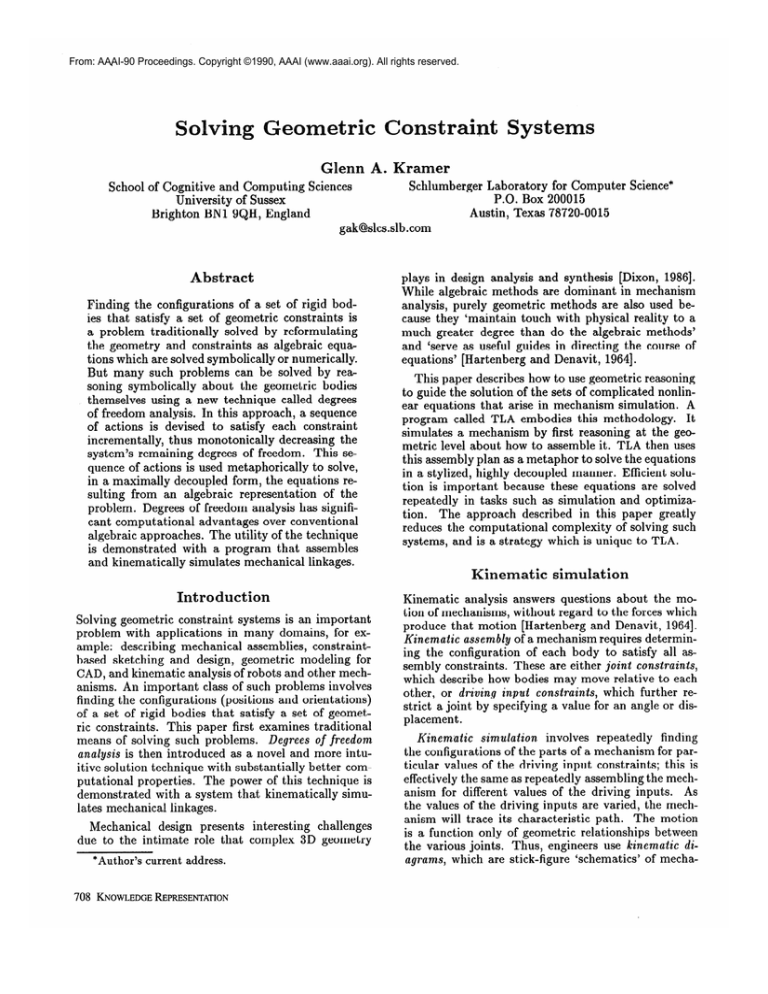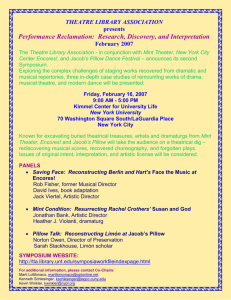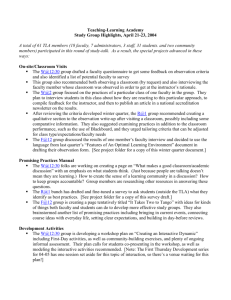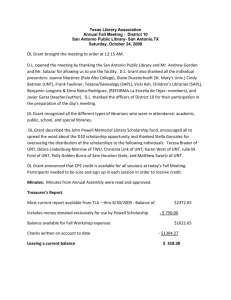
From: AAAI-90 Proceedings. Copyright ©1990, AAAI (www.aaai.org). All rights reserved.
etric
Glenn
Constrai
Systems
A. Kramer
Schlumberger Laboratory for Computer Science*
School of Cognitive and Computing Sciences
P.O. Box 200015
University of Sussex
Austin, Texas 78720-0015
Brighton BNl 9&H, England
gak@slcs.slb.com
Abstract
Finding the configurations of a set of rigid bodies that satisfy a set of geometric constraints is
a problem traditionally solved by reformulating
the geometry and constraints as algebraic equations which are solved symbolically or numerically.
But many such problems can be solved by rea
soning symbolically about the geometric bodies
themselves using a new technique called degrees
of freedom analysis. In this approach, a sequence
of actions is devised to satisfy each constraint
incrementally, thus monotonically decreasing the
system’s remaining degrees of freedom. This sequence of actions is used metaphorically to solve,
in a maximally decoupled form, the equations resulting from an algebraic representation of the
problem. Degrees of freedom analysis has significant computational advantages over conventional
algebraic approaches. The utility of the technique
is demonstrated with a program that assembles
and kinematically simulates mechanical linkages.
Introduction
Solving geometric constraint systems is an important
problem with applications in many domains, for example: describing mechanical assemblies, constraintbased sketching and design, geometric modeling for
CAD, and kinematic analysis of robots and other mechanisms. An important class of such problems involves
finding the configurations (positions and orientations)
of a set of rigid bodies that satisfy a set of geometric constraints. This paper first examines traditional
means of solving such problems. Degrees of freedom
analysis is then introduced as a novel and more intuitive solution technique with substantially better computational properties. The power of this technique is
demonstrated with a system that kinematically simulates mechanical linkages.
Mechanical design presents interesting challenges
due to the intimate role that complex 3D geometry
*Author’s current address.
708
KN~WLEDGEREPRESENTATION
plays in design analysis and synthesis [Dixon, 19861.
While algebraic methods are dominant in mechanism
analysis, purely geometric methods are also used because they ‘maintain touch with physical reality to a
much greater degree than do the algebraic methods’
and ‘serve as useful guides in directing the course of
equations’ [Hartenberg and Denavit, 19641.
This paper describes how to use geometric reasoning
to guide the solution of the sets of complicated nonlinear equations that arise in mechanism simulation. A
program called TLA embodies this methodology.
It
simulates a mechanism by first reasoning at the geometric level about how to assemble it. TLA then uses
this assembly plan as a metaphor to solve the equations
in a stylized, highly decoupled manner. Efficient solution is important because these equations are solved
repeatedly in tasks such as simulation and optimization. The approach described in this paper greatly
reduces the computational complexity of solving such
systems, and is a strategy which is unique to TLA.
Kinematic
simulation
Kinematic analysis answers questions about the motion of mechanisms, without regard to the forces which
produce that motion [Hartenberg and Denavit, 19641.
Kinematic assembly of a mechanism requires determining the configuration of each body to satisfy all assembly constraints. These are either joint constraints,
which describe how bodies may move relative to each
other, or driving input constraints, which further restrict a joint by specifying a value for an angle or displacement.
Kinematic
simulation
involves repeatedly finding
the configurations of the parts of a mechanism for particular values of the driving input constraints; this is
effectively the same as repeatedly assembling the mechanism for different values of the driving inputs. As
the values of the driving inputs are varied, the mechanism will trace its characteristic path. The motion
is a function only of geometric relationships between
the various joints. Thus, engineers use kinematic diagrams, which are stick-figure ‘schematics’ of mecha-
nisms. They contain only geometry relating the joints,
not the actual shapes or boundaries of the parts. They
help designers understand a mechanism’s kinematic behavior. This research is concerned with simulating
mechanisms at the level of kinematic diagrams.
Mechanical
constraints
Constraints describing joint behavior can be modeled
as relationships between sets of points on different bodies. A marker consists of a point in 3D space, along
with two orthogonal axes, z and x, which emanate from
the point. The position of a marker is the position of
its point, while its orientation is determined by its axes.
Since all bodies are rigid, constraints between markers
constrain the bodies to which they are attached. The
constraints between pairs of markers ml and m2 are:
Markers ml
coincident (ml, mz):
tially coincident.
and m2 are spa-
in-line(ml, m2): ml lies on the line through m2 parallel to mfL’s z axis.
in-plane(ml,
m2):
ml
normal to m2’s z axis.
parallel-z( ml, m2):
are parallel.
perpendicular-z(ml
are perpendicular.
lies in the plane through
m2
the z axes of markers ml and m2
, ml:):
the z axes of ml and m2
the z axes of ml and m2 are
parallel; and the angle from ml’s x axis to mz’s x axis
co-oriented(ml,
ma, a):
is LY.
m2, S): the z axes of ml and m2 are parallel; and the angle from ml’s x axis to m2’s x axis is
linearly related to the distance between ml and m2 by
a pitch constant S.
screw(ml,
Combinations of these constraints, relating markers on different rigid bodies, may be used to model
all of the ‘lower pair’ joints described by Reuleaux
,, [Reuleaux, 18761. For example, a revolute joint, which
allows one rotational degree of freedom between two
bodies, is modeled with a coincident constraint and
a parallel-z constraint. A translational, or prismatic,
joint is modeled with an in-line constraint and a cooriented joint. Some types of higher pairs may also be
modeled with the above constraints, for example, the
‘universal’joint and ‘slotted pin’joint. The constraints
defined above are sufficient to describe all mechanical
linkages as well as many static mechanical assemblies;
there is no restriction to ‘fixed axis’ mechanisms as is
common in the literature [Faltings, 1989; Joskowicz,
19871.
Figure 1 illustrates the modeling of a crank-slider
mechanism. The crank-slider consists of three parts.
The ground, G, is fixed in space, and serves as the
global reference frame. Markers gl and 92 are therefore
also grounded, or fixed in space. In the figure, marker
rl -
R
t-2
(4
G
04
Figure 1: Crank-slider: (a) parts; (b) assembled.
z axes are shown in black; if not shown, they point out
of the page. Relevant marker x axes are shown in grey.
The geometric constraints are:
gl)
coincident (r2, cl)
paralleLz(r2, cl)
in-line(r1,
coincident (92, c2)
paralleLz(g2, c2)
co-oriented(g2, c2, (Y)
The in-line constraint models a pin (~1) in a slot
(gl’s z axis). The coincident, parallel-z pairs model
revolute joints. The revolute joint 92, c2 has a driving
input cy, which fully constrains crank C’s position and
orientation relative to ground. Rotation of the crank
is accomplished by changing the value of Q. As the
crank C rotates, marker rl of the connecting rod R
slides along the z axis of grounded marker gl.
Equational
solution
Constraint systems like the crank-slider described
above are usually solved by modeling the geometry and
constraints with algebraic equations. A local coordinate frame is assigned to each body. Then the configuration variables of the different bodies - the six quantities that uniquely specify a local coordinate frame
[Snyder, 19851 - are related by equations that model
the problem constraints. Solving these equations yields
the desired configuration for each b0dy.l A simple example, involving a single rigid body, illustrates the solution of a small set of such equations: the brick of
Figure 2 must be configured to satisfy the three co‘Solving
these types of equations
for robotics
applications is usually not too difficult because most robot manipulators
are open-loop
mechanisms.
Mechanical
linkages, however, involve closed loops. This leads to a much
greater degree of equation coupling.
Hence, solving these
equations must be done simultaneously
and is substantially
more difficult .
KRAMER
709
b3
Figure 2: A brick with three coincident constraints.
incident constraints graphically depicted as the grey
lines between the brick’s markers bl, b2, b3 and the desired locations, denoted by markers gl, 92, g3 fixed in
the global coordinate frame. Equations are developed
to relate the configuration variables of the brick’s coordinate frame to those of the global coordinate frame.
The equations may then be solved either numerically
or symbolically.
Figure 3: Brick solution using Newton-Raphson.
b2”
Numerical solution
Numerical solutions represent constraints using error
which have zero value when the constraint is
satisfied, and otherwise have some value proportional
to the degree to which the constraint is violated. The
objective function
is the sum of all error terms. Numerical techniques try to find a zero of the objective
function by ‘sliding’ down the function’s gradient. This
process is necessarily iterative for nonlinear problems,
which include any problem involving rotation. Figure 3 shows, in grey, some of the intermediate configurations reached using Newton-Raphson iteration (one
of the most efficient methods [Press et al., 19861) to
move the brick from its initial configuration to one
satisfying the constraints. Numerical techniques have
many drawbacks. Each iteration of Newton-Raphson is
slow, taking O(n3) time, where n is the number of constraints. Overconstrained situations, which are quite
common, require pre- and post-analysis to remove redundant constraints before solving and to check them
later for consistency.
terms,
Symbolic solution
Symbolic solutions use algebraic re-write rules or other
techniques to isolate the configuration variables in the
equations in a predominantly serial fashion. Once a
solution is found, it may be re-used (executed) on any
topologically equivalent problem. Execution is fast,
approximately linear in the number of constraints. If
numerical stability is properly addressed, the solution
can be more accurate by virtue of being analytic; there
is no convergence tolerance as found in numerical techniques. The principal disadvantage of symbolic techniques is the excessive - potentially exponential time required to find a solution or determine one does
not exist. Poorly-chosen configuration variable assign710
KN~WLEDOEREPRESENTATION
Figure 4: Brick solution using geometric approach.
ments can exacerbate the problem by coupling the
equations in unnecessarily complicated ways, requiring more clever and complex inferences. Thus, the
symbolic techniques are feasible and complete only for
small problems.
Many shortcomings of the above methods can be
traced to problems inherent in the configuration variable representation and the complexity of the resulting equations. This suggests a different approach to
the solution of geometric constraint problems: avoid
equational reformulation entirely, reasoning instead directly about the geometric entities. A program called
TLA has been developed to do this.
Geometric
solution
TLA solves the brick problem using geometric knowledge to satisfy the constraints incrementally.
The
solution is shown in Figure 4.
Assume that initially the brick is free to move anywhere; it just happens to be in the given initial configuration CO. To
satisfy coincident (bl, g 1) , TLA translates the brick
by the vector from bl to gl, leaving the brick in
configuration C1. To ensure coincident (bl , g 1) remains satisfied, all further actions that move the brick
must be rotations about gl, i.e., the brick has only
its rotational degrees of freedom left.
To satisfy
coincident (b3, g3), TLA measures the vector v 1 from
g 1 to b3’ (where b3 has been moved by the previous translation) and vector v2 from gl to g3. These
two vectors are shown as dashed lines in Figure 4.
Then TLA rotates the brick about gl around vector
vl x v2 by the angle between vl and v2, to configuration C2. This satisfies coincident(b3,g3) without
violating coincident (b 1, g 1). This action also removes
two of the remaining rotational degrees of freedom; in
order to preserve the two already-satisfied constraints,
all future actions must be rotations about v2. To
satisfy the final constraint, TLA drops perpendiculars
from b2” to v2, and from g2 to v2, and rotates the
brick about v2 by the angle between the perpendiculars. This brings the brick to its final configuration.
The solution is very deliberate, as opposed to the meandering of the numerical approach of Figure 3. The
sequence of actions performed above constitute a plan
for moving the brick from an arbitrary position to one
satisfying the constraints.
For this part of the problem solution, TLA reasons
only about geometry, actions and degrees of freedom.
No equations are developed, and no model requiring configuration variables or other abstract state is
needed. Constraints are satisfied by measuring the
brick’s geometric properties (often using additional
geometric constructions) and then moving it. This
method is called degrees of freedom analysis.
The
brick-moving plan derived using this method is next
used to solve for the brick’s configuration variables as
represented in a computer; this may be done regardless of how the local coordinate frame of the brick is
described. All that is required is a set of operators
for translating and rotating rigid bodies, and a set of
functions that can measure, relative to a global coordinate system, points and vectors attached to any rigid
body. These capabilities are provided by homogeneous
coordinate transforms [Snyder, 19851, which most 3D
graphics and robotics systems use.
The plan, when executed, becomes a metaphor for
solving the equational representation of the constraint
system. By using the primitive actions of translation
and rotation, which are implemented as matrix multiplications, the plan effectively decouples the equations into small independent sets that can be solved
analytically. 2 As new constraints are satisfied, previously satisfied constraints (which may correspond to
complicated relations between configuration variables)
become invariants for later steps in the solution. Geometry, as used in the metaphorical plan, provides
the vocabulary and operators that allow preserving
these invariants. The use of the assembly plan as a
metaphor to guide equation solution distinguishes TLA
2Not all problems may be solved analytically;
some require iterative
solutions.
In such cases TLA fails in the
plan construction
phase. It is possible, however, to use the
information
from the failure to reduce significantly
the dimensionality
of the iterative problem that must be solved.
See [Kramer, in preparation]
for details.
from other programs that solve large sets of nonlinear
equations.
Since the plan does not depend on metric properties
of the problem, it can be executed on any topologitally equivalent problem. 3 The time required for plan
generation is thus amortized over repeated executions.
Degrees
of freedom
analysis
TLA keeps track of the number and types of degrees of
freedom each body (or link) has as it solves a problem. It represents this information with predicates
of the form link-has-n-TDOF(linL,
arg1, arg2, . . . )
and link-has-n-RDOF(ZinE,
arg1, arg2, . . . ), for
n E (0, 1,2,3). TDOF stands for translational degrees
of freedom, and RDOF for rotational degrees of freedom. The arguments urgl, urg2, . . . specify any fixed
points or axes on the links that restrict their freedom.
Initially, every link in the system except the grounded
body has 3 TDOF and 3 RDOF. As actions are taken to
satisfy constraints, the links in the system lose some of
their degrees of freedom. When all bodies have 0 TDOF
and 0 RDOF, the problem is solved.
At each step in solving for a body’s configuration,
must know what action to take given the body’s
current constraints, and how that action further reduces the body’s degrees of freedom. This information is stored in a plan fragment table. Conceptually,
the plan fragment table is a three-dimensional dispatch
table, indexed by TDOF, RDOF, and constraint type.
Each entry in the table specifies how to move the rigid
body to satisfy the new constraint using only available
degrees of freedom, and what degrees of freedom the
body will have after the action is performed. The plan
fragment table contains information about how to satisfy constraints when one of the markers participating
in the constraint has its appropriate attributes fixed,
or globally known. Thus, a globally known position of
one marker is required for solving a coincident constraint, and a globally known z axis is needed to solve
a perpendicular-z constraint.
TLA
In the brick example, the first constraint to be satisfied is arbitrarily chosen to be coincident(b1, gl). The
global position of gl is known. Initially the brick has 3
TDOF
and 3 RDOF; thus the index into the plan fragment table is (3,3, coincident). This entry contains
the following information (modified for readability):
Initial state:
link-has-3-TDOF(
link-has-3-lXDOF(
link)
Zink)
Mathematical
degen3Actually,
this is not quite true.
eracies may cause the plan to fail. For example,
the brick
plan fails to remove the final rotational
degree of freedom
if the three markers are collinear.
TLA can test for such
degeneracies,
and try to generate
a new plan taking them
into account, if possible.
KRAMER
711
Plan fragment:
begin
translat e( link,
vector-difference(gmp( Ml),
gmP(M2)));
end;
New state:
link-has-0-TDOF(
link-has-3-RDOF(
bl, $2
Zink, gmp( M2))
link)
I
/’
Explanation:
.i
Body link is free to translate. A coincident
constraint must be satisfied between marker M1,
whose global position is known, and marker M2
on link. Therefore link is translated by the vector from the current global position of M2 to the
known global position of M1. This action removes all three translational degrees of freedom.
The variable Zink is bound to the object representing the brick. The initial state of the link is that it
has all six of its degrees of freedom; it is free to translate and rotate through space. The variable Ml gets
bound to the globally known marker (i.e., gl), while
variable M2 is bound to the underconstrained marker
in the coincident constraint being satisfied (i.e., bl).
The plan fragment specifies how to move the body to
satisfy the constraint (the function name gmp stands
for “global marker position”). In the specification of
the new state, the predicate link-has-0-TDOF
has
an additional argument which specifies the point on
the body which is constrained to be stationary. The
textual explanation - with variable names replaced
by their bindings - helps the user to understand the
solution process.
The next constraint satisfied in the brick example is
coincident(b3, g3). Since the brick now has 0 TDOF
and 3 RDOF, the index into the plan fragment table
is (0,3, coincident). The plan fragment in that entry
specifies how to rotate a body with 0 TDOF, 3 RDOF
to satisfy a coincident constraint, and specifies that
the new state of the body is 0 TDOF,
1 RDOF. The
process continues until all constraints are satisfied.
For the constraints defined in this paper, there are
112 valid entries in the plan fragment table; some
plan fragments are quite simple, like the one described
above, while others involve more complex calculations
and conditionals to handle potential mathematical degeneracies. The complete plan fragment table appears
in [Kramer, in preparation].
Interacting
bodies
Bodies rarely interact exclusively with fixed points, as
in the brick example. Often, they interact with other
partially constrained bodies. In Figure 5 body A is
constrained to 0 TDOF,
1 RDOF by the constraints
712
KN~WLEDOEREPRESENTATION
\
/’
q+<.’
“%.
.y
‘....-15....
c
.......““-*~..-c ‘.-..
.’
----..--.....
...*.
........-.--*
Figure 5: Solving for two interacting bodies (z axes
point out of the page).
coincident(a1, gl) and parallel-z(u1, gl). TLA infers
that marker a2 must lie on a circle about al. Body B
is similarly constrained. To satisfy coincident (a2, b2),
TLA intersects the circles to find the two globally acceptable locations for the markers. TLA distinguishes
the locations with a branch variable q. A user of TLA
chooses which solution to use by specifying the value of
q. TLA places a ‘pseudo-marker’ p at the this location;
this is a marker which is not part of the original problem specification, but is introduced during the problem
solution.
With the intersection point defined, TLA satisfies
the coincident constraint for bodies A and B independently. It does this by introducing the constraints
coincident (p, ~2) and coincident (p, b2).
Since v’s
position is globally known, the plan fragment table
may be used to find the appropriate actions to satisfy the two introduced constraints. When they are
satisfied, coincident(u2, b2) is also satisfied.
In this manner, local information, in the form of
loci of points on partially constrained bodies, may
be combined through locus intersection to yield information about globally permissible locations of points.
Pseudo-markers denote these intersections, and auxiliary constraints are introduced to relate the partiallv
constrained markers to the pseudo-marker. Then the
plan fragment table is used to find the appropriate actions to satisfy the constraints.
TLA uses a locus table to specify the loci to which
pa.rtially constrained markers are confined. Loci are
determined completely by the degrees of freedom that
a body has. For example, all markers on a body with 0
TDOF,
1 RDOF are constrained to lie on circles around
the body’s fixed point. Markers on a body with 0
TDOF,
3 RDOF must lie on spheres, and markers on a
body with 2 TDOF, 0 RDOF must lie in planes.
A locus intersection tubZe allows TLA to know when
enough information is known about sets of partially
constrained markers to determine their configurations
fully. This table has entries for all pairs of shapes in the
locus table. For example, a sphere intersected with a
circle yields at most two discrete points (except in the
degenerate case of the circle lying on the sphere); a
plane intersected with a cylinder yields an ellipse. For
the constraints described in this paper, all loci are analytically describable, as are all pairwise intersections
of loci.
Plan generation
(1
The plan fragment table and locus tables allow simple and efficient algorithms to solve geometric constraints. TLA’s metaphorical plan construction differs from blocks world planners like HACKER
[Sussman, 19731, which generate physically realizable plans
to get from one world state to another. Kinematic diagrams do not represent the true physical boundaries of
the mechanism’s parts, so the geometric entities may
pass through each other in intermediate plan states
as they move toward their final configurations. TLA’s
only concern is the final plan state, where all objects
satisfy their constraints. This lack of concern about intermediate states allows TLA to satisfy the constraints
incrementally, without backtracking.
An assembly plan generated by TLA is compiled into
an assembZy procedure, which is a machine executable
version of the plan. The assembly procedure is optimized in various ways: removing nested function calls,
removing duplicate calculations, etc. Mechanism simulation is accomplished by alternately changing the values of the driving inputs and then calling the assembly procedure; the simulation moves the mechanism
through its characteristic motions.
The assembly procedure may be reused when the
sizes and shapes of the parts change; however, if the
mechanism topology (e.g., number of bodies, or number or types of joints connecting the bodies) changes,
a new assembly plan and procedure must be derived.
Implementation
The current version of TLA is written in Common
Lisp and CLOS, and runs on a Symbolics Lisp Machine. A rule-based system generates the assembly
plans. Each rule implements part of the plan fragment table or the locus tables, of which about 60%
have been implemented to date. A database stores assertions during the assembly planning. The database
grows monotonically; no retractions are made. A simple pattern matcher is used, rather than full unification, and the few search heuristics (for efficiency only)
are hard-wired into the rule triggers. This allows a
simple control structure:
o Make any applicable deduction (e.g., ‘marker m lies
on a circle’).
e Perform any applicable action
rotation).
h.,
a translation or
e Succeed when all bodies have zero degrees of freedom.
e Fail when there is no applicable deduction or action.
While a rule-based system allowed flexibility in deciding how TLA would be structured, a future implementation will use explicit tables and object-oriented
programming to avoid the need for pattern matching,
substantially reducing the computational complexity
of constructing assembly plans.
Complexity
analysis
A complete analysis of the computational complexity
of TLA is given in [Kramer, in preparation]; only the
results appear here. For the rule-based implementation, plan generation time is O(nd), where n is the
number of constraints, and d is a constant determined
by the average number of arguments for each database
predicate (CaM 3). In practice, TLA’s plan generator
tends to run in time nearly proportional to n2.
Thus, for generating a solution, TLA’s planning algorithm has polynomial complexity, as opposed to the exponential complexity of symbolic algebraic techniques.
For executing a solution, TLA’s compiled plan runs in
O(n.) time, as opposed to the O(n3) time of iterative
numerical methods.
Speed
comparisons
has simulated dozens of complex planar and spatial mechanisms, the largest example being a sofa-bed,
shown in Figure 6. This mechanism has 16 links, 22
joints, and two driving inputs, and is described by 115
algebraic constraints, 19 of which are redundant. A
plan is generated in 297 seconds, and the assembly
procedure compiled from it (655 lines of Lisp code)
executes in 0.29 seconds on a Symbolics 3675. This
is almost two orders of magnitude faster than simulation speeds using some of the commercially available
numerically-based simulators, after scaling for differences in processor speed (commercial programs run on
machines other than the Symbolics).
TLA
Discussion
Algebra has long been the lingua fruncu of science and
engineering, but it can provide only a partial appreciation of the actual domain under study. An understanding of geometry is essential to solving problems insightfully and efficiently in the mechanical world. TLA
demonstrates this for the task of mechanical assembly
and simulation. By using geometry to guide equation
solving, TLA provides orders of magnitude speedup
over ‘general-purpose’ mathematical techniques. This
KRAMER
713
thesis, Stanford
July 1979.
University,
Stanford,
California,
[Dixon, I.9861 John R. Dixon.
Artificial intelligence
and design: A mechanical engineering view. In Proceedings of the National Conference
on Artificial
telligence, pages 872-877, Seattle, WA, 1986.
In-
[Faltings, 19891 Boi Faltings. Reasoning about kinematic topology. In Proceedings of the International
Joint Conference
on Artificial Intelligence,
Detroit,
Michigan, August 1989.
Figure 6: Sofa-bed mechanism (extended).
means that interactive tools for the simulation, optimization, and synthesis of complex mechanical devices
become feasible [Kramer and Barrow, 19891.
Using degrees of freedom analysis to generate an
assembly plan, and using the resulting plan as a
metaphor -to guide equation solution both appear
unique to TLA. Sketchpad [Sutherland, 19631 and
ThingLab [Borning, 19791 represented geometric constraints equationally, relying on relaxation for nonlinear equations. Popplestone et al. explored, with limited success, solving assembly problems algebraically
using some geometric guidance [Popplestone eZ al.,
19861. More recently Popplestone has focused on using group theory to represent geometric symmetries
[Popplestone, 19871. Th is work could profitably be
incorporated into TLA. Faltings [Faltings, 19891 and
Joskowicz [Joskowicz, 19871 are investigating deriving
kinematic constraints directly from geometry. Such
a facility would free the user of TLA from having to
model a mechanism in terms of abstract concepts like
markers.
The ideas embodied in TLA may be extended in
many ways, including: expanding the range of constraints TLA understands (e.g., gears, cams, etc.); analyzing dynamic behavior more efficiently by virtue of
understanding the kinematics; using knowledge of geometry to aid-in design synthesis. In all of these cas&,
geometric knowledge leads to a better understanding
of the underlying mathematics.
Degrees of freedom
analysis allows unifying geometric reasoning with algebraic techniques for efficient and intuitive modeling
of real-world mechanisms and assemblies.
[Hartenberg and Denavit, 19641 R. S. Hartenberg and
J. Denavit. Kinematic Synthesis of Linkages. McGraw Hill, New York, 1964.
[Joskowicz, 1987’1 Leo Joskowicz. Shape and function
in mechanical devices. In Proceedings of the National
Conference
on Artificial Intelligence,
Seattle, WA,
August 1987.
[Kramer and Barrow, 19891 Glenn A. Kramer and
IIarry G. Barrow. New approaches to linkage synthesis. In International
Joint Conference
on Arti(video track), Detroit, Michigan,
ficial Intelligence
August 1989.
[Kramer, in preparation] Glenn A. Kramer.
Geometric Reasoning in the Kinematic
Analysis of Mechanisms. PhD thesis, University of Sussex, Brighton,
UK, (in preparation).
[Popplestone et al., 19801 R. J. Popplestone, A. P.
Ambler, and I. M. Bellos. An interpreter for a language for describing assemblies. Artificial Intelligence, 14( 1):79-107, August 1980.
[Popplestone, 19871 R. J. Popplestone. The Edinburgh
Designer System as a framework for robotics or, the
design of behavior. COINS Technical Report 8747, University of Massachusetts, Amherst, MA, May
1987.
[Press et QZ.,19861 William H. Press, Brian P. Flannery, Saul A. Teukolsky, and William T. Vetterling.
Numerical
Recipes:
The Art of Scientific
Computing. Cambridge University Press, Cambridge, Eng-
land, 1986.
[Reuleaux, 18761 M. M. Reuleaux.
The Kinematics
of Machinery.
Macmillan & Co., New York, 1876.
Translated by Alex B. W. Kennedy.
[Snyder, 19851 Wesley E. Snyder.
Acknowledgments
Computer
Phil Agre helped implement the latest version of TLA,
and contributed technically in many ways. I would
also like to thank Harry Barrow, David Barstow,
Geoff Goodhill, David Gossard, Walid Keirouz, Mark
Shirley, Reid Smith, Bob Young, and David Ullman.
Interfacing
Series. Prentice-Hall,
Jersey, 1985.
Industrial
[Sussman, 19731 Gerald Jay Sussman. A Computational Model of Skill Acquisition.
PhD thesis, MIT,
Cambridge, Massachusetts, August 1973.
[Sutherland, 19631 -Ivan E. Sutherland.
References
[Borning, 19791 Alan
Constraint-Oriented
714
H.
Borning.
Simulation
KN~WLED~EREPRESE~~TA~~N
A Man-Machine
Thingla b:
A
Laboratory.
PhD
Robots:
Industrial Robot
Inc., Englewood Cliffs, New
and Control.
Graphical
Communication
Sketchpad:
System.
PhD thesis, MIT, Cambridge, Massachusetts, 1963.





